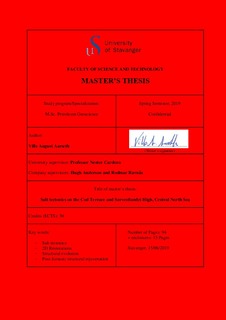| dc.contributor.advisor | Cardozo, Nestor | |
| dc.contributor.advisor | Ravnås, Rodmar | |
| dc.contributor.advisor | Anderson, Hugh | |
| dc.contributor.author | Aarseth, Ville August | |
| dc.date.accessioned | 2019-09-30T11:29:34Z | |
| dc.date.available | 2019-09-30T11:29:34Z | |
| dc.date.issued | 2019-06-15 | |
| dc.identifier.uri | http://hdl.handle.net/11250/2619362 | |
| dc.description | Master's thesis in Petroleum Geosciences Engineering | nb_NO |
| dc.description.abstract | Four high- to moderate-quality 3D seismic surveys and public well data were used to define the structural framework and understand the Mesozoic and Cenozoic structural evolution of the salt diapirs on the Cod Terrace and the Sørvestlandet High. The salt is part of the Late Permian Zechstein Group, and is composed of mobile halite and less mobile anhydrites, carbonates and siliciclastics. Structural restorations of four salt structures on the Cod Terrace and Sørvestlandet High are used in order to understand their development. The results are broadly consistent with the “pod-interpod” model, where Late Jurassic extension led to diapir collapse, generating sediment accommodation above the diapirs. However, this does not apply to the evolution of all diapirs in the area, nor does it include Cenozoic salt remobilization. Based on their present-day geometries and associated sediment growth, the studied diapirs are classified as: buried diapirs; collapsed diapirs; reactivated diapirs; salt walls and rollers; and salt stocks. The collapsed and reactivated diapirs on the Cod Terrace and Sørvestlandet High are the focus of this study. The collapsed diapirs (e.g. Ula structure) experienced collapse and salt withdrawal during Jurassic – Early Cretaceous and structural rejuvenation in the Late Cretaceous – Early Paleogene, followed by Cenozoic burial. The reactivated diapirs (e.g. Oda structure) underwent minor collapse during Jurassic – Early Cretaceous and major structural rejuvenation during Cenozoic shortening. The deformation caused by salt movement in these diapirs influence the petroleum system by facilitating (1) the accommodation of Jurassic sediments (reservoir units) above the diapirs during salt withdrawal, and (2) the formation of anticlines immediately after Jurassic deposition, or the uplift of sediments on the diapir flanks (traps). Risks related to reservoir presence and trap failure are higher in the reactivated diapirs (i.e. on the Sørvestlandet High), due to minor Jurassic salt withdrawal and extensive Cenozoic deformation. This study shows that the interpretation of high-quality 3D seismic data together with structural restorations, increases the understanding of the link between salt movement and sedimentation in this area. | nb_NO |
| dc.language.iso | eng | nb_NO |
| dc.publisher | University of Stavanger, Norway | nb_NO |
| dc.relation.ispartofseries | Masteroppgave/UIS-TN-IER/2019; | |
| dc.rights | Navngivelse 4.0 Internasjonal | * |
| dc.rights.uri | http://creativecommons.org/licenses/by/4.0/deed.no | * |
| dc.subject | 2D restorations | nb_NO |
| dc.subject | petroleumsgeologi | nb_NO |
| dc.subject | petroleum geology | nb_NO |
| dc.subject | salt tectonics | nb_NO |
| dc.subject | structural evolution | nb_NO |
| dc.subject | post-Jurassic structural rejuvenation | nb_NO |
| dc.title | Salt tectonics on the Cod Terrace and Sørvestlandet High, Central North Sea | nb_NO |
| dc.type | Master thesis | nb_NO |
| dc.description.version | submittedVersion | nb_NO |
| dc.subject.nsi | VDP::Mathematics and natural science: 400::Geosciences: 450::Petroleum geology and petroleum geophysics: 464 | nb_NO |
| dc.subject.nsi | VDP::Technology: 500::Rock and petroleum disciplines: 510::Geological engineering: 513 | nb_NO |

